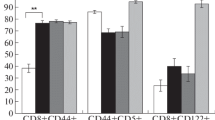Summary
Recently we published a hypothesis on the immunological events occurring during tumor rejection. One of the implications of this hypothesis is that specific macrophage-arming factor (SMAF) is produced early during the initiation of the immune response, whereas the “classical” cell-mediated immune response components, such as cytotoxic T lymphocytes (CTL), are produced later, that is, during the amplifier-effector phase. In this paper we establish the kinetics of the induction of (a) lymphocytes producing SMAF and (b) CTL. Groups of DBA/2 mice were injected i.p. once, twice or three times with irradiated and/or non-irradiated syngeneic SL2 tumor cells, the injections being given at intervals of 10 days. After each of these injections the production of SMAF and the expression of CTL activity were established. The results showed that in the peritoneal cavity SMAF-producing lymphocytes appeared earlier than cytotoxic lymphocytes (CTL). In addition, it was shown (a) that SMAF does not interfere with the in vitro cytotoxicity expressed by CTL and (b) that in addition to CTL memory cells, SMAF-producing memory cells were also induced after injection of syngeneic tumor cells. These data support the hypothesis that SMAF is involved in the early phase of the cellular immune response against tumors, whereas CTL are induced later.
Similar content being viewed by others
References
Askenase PW, Van Loveren H (1985) Delayed-type hypersensitivity: activation of mast cells by antigen-specific T-cell factors initiates the cascade of cellular interactions. Immunol Today 4: 259
Blazar BA, Galik N, Klein E (1984) Effect of the isolated tumor lymphocytes alone and with adherent cells. Cancer Immunol Immunother 18: 179
De Groot JW, De Weger RA, Den Otter W (1989) The difference in the induction of tumoricidal activity by the specific T-lymphocyte factor SMAF and the lymphokine MAF. Immunobiology, (in press)
De Heer E, De Groot JW, Den Otter W, Dullens HFJ (1982) Peritoneal cell populations during tumor rejection. Int J Tissue React. IV: 81
De Weger RA (1987) The initiation of immune reactions to tumor cells. Res Monographs Immunol 11: 41
De Weger RA, Den Otter W (1986) Induction of specific macrophage cytotoxicity. Methods Enzymol 132: 531
De Weger RA, Pels E, Den Otter W (1982) The induction of lymphocytes with the capacity to render macrophages cytotoxic in an allogeneic murine system. Immunology 47: 541
De Weger RA, Dullens HFJ, De Boer RJ, Den Otter W (1985) Mathematical analysis of the cellular immune reaction against tumor cells. Immunol Today 6: 316
De Weger RA, Van Loveren H, De Groot JW, Rangarajan R, Den Otter W (1986) Lymphocyte-induced macrophage cytotoxicity. III. Induction of specific macrophage cytotoxicity is independent of lipopolysaccharide. Immunobiology 171: 170
De Weger RA, Wilbrink B, Moberts RMP, Mans D, Oskam R, Den Otter W (1987) Immune reactivity in SL2 lymphoma bearing mice compared with SL2-immunized mice. Cancer Immunol Immunother 24: 25
De Weger RA, Vandebriel RJ, Slager H, Mans D, Van Loveren H, Wilbrink B, Dullens HFJ, Den Otter W (1989) Initial immunochemical characterization of specific macrophage arming factor. Cancer Immunol Immunother 30: 21–27
Dullens HFJ, Vuist W, Van der Maas M, Den Otter W (1986) The role of host lymphocytes and host macrophages in antitumor reaction after injection of sensitized lymphocytes and tumor target cells into naive mice. Cancer Immunol. Immunother 23: 113
Dullens HFJ, Schakenraad S, Oostdijk A, Vuist W, Van der Maas M, Den Otter W (1986) Specific tumoricidal activity of cytotoxic macrophages and cytotoxic lymphocytes. Cancer Immunol Immunother 22: 100
Evans R, Alexander P (1972) Role of macrophages in tumor immunity. I. Cooperation between macrophages and lymphoid cells in syngeneic tumor immunity. Immunology 23: 625
Julius MH, Simpson E, Herzenberg LA (1973) A rapid method for the isolation of functional thymus derived murine lymphocytes. Eur J Immunol 3: 645
Los G, De Weger RA, Moberts RMP, Van Loveren H, Sakkers RJ, Den Otter W (1987) The absence of delayed type hypersensitivity reactivity in a syngeneic murine tumor system. Immunology 62: 89
Pels E, De Weger RA, Den Otter W (1984) Lymphocyte induced macrophage cytotoxicity: characterization of the cytotoxicity inducing lymphocytes. Immunobiology 166: 84
Ptak W, Bereta M, Ptak M, Askenase PW (1986) Isotype-like suppression of T-cell-mediated immunity in vivo. I. Delayedtype hypersensitivity specificity of T-cell suppression induced by antigen-binding T cell factors that initiate contact sensitivity. J Immunol 1986: 136
Ptak W, Bereta M, Ptak M, Askenase PW (1981) Isotypelike suppression of T-cell mediated immunity in vivo. II. Suppression of the early component of contact sensitivity by a Ly-2+ T-cell-derived suppressor factor that binds to contact sensitivity-initiating, antigen specific, Ly-1+ T-cell derived factors that are of different antigen specificities. J Immunol 136: 1564
Romani L, Nardelli B, Bianchi R, Puccettio P, Mage M, Fioretti MC (1985) Adoptive immunotherapy of intracerebral murine lymphomas: role of different lymphoid populations. Int J Cancer 35: 659
Sugarbacker PH, Mattews W (1986) Early antigen elimination by cytotoxic T-cells results in diminished cellular immune responses to allogeneic tumors. Cell Immunol 57: 114
Vandebriel RJ, De Weger RA, Los G, Van Loveren H, Wiegers GJ, Oude Weernink PA, Den Otter W (1989) Two specific T-cell factors that initiate immune responses in murine allograft systems. A comparison of biological functions. J Immunol (in press)
Van Loveren H, De Groot JW, Koten JW, Piersma AH, De Weger RA, Den Otter W (1984) A macrophage factor enhancing the systemic anti-tumor effect of T-lymphocytes. Immunobiology 166: 118
Van Loveren H, De Weger RA, Garssen J, Los G, Askenase PW (1988) Impairment of allograft immunity by isotype-like suppression of antigen specific T-cell factors. Transplantation (in press)
Author information
Authors and Affiliations
Rights and permissions
About this article
Cite this article
Dullens, H.F.J., De Weger, R.A., Van Der Maas, M. et al. Production of specific macrophage-arming factor precedes cytotoxic T lymphocyte activity in vivo during tumor rejection. Cancer Immunol Immunother 30, 28–33 (1989). https://doi.org/10.1007/BF01665027
Received:
Accepted:
Issue Date:
DOI: https://doi.org/10.1007/BF01665027




